Discover Florida Nature
It's time to explore the natural Florida


|
|
|
|
|
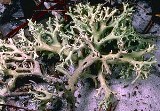 Florida
perforate cladonia (Cladonia perforata)- Florida perforate
cladonia is a terrestrial lichen grown in tufts 0.8 - 2.5 inches tall,
consisting of densely forking branches. The lichens branches grow up to
0.24 inch wide, and are hollow, smooth, and glossy. Cladonia perforata
is pale yellowish-gray, and intricately forked with large, conspicuous
holes below each branching point. This lichen is one of two on the U.S.
Endangered Species List, and it should never be collected. It exists
only in a few small populations in Florida. Fewer than 30 populations of
Florida perforate cladonia are known, about half of those exist on
conservation lands. Florida perforate cladonia is found on Rosemary
scrub in the Florida Panhandle, Lake Wales Ridge, and Atlantic Coastal
Ridge. Perforate reindeer lichen populations in the Panhandle were
severely impacted by Hurricane Opal in 1995. Florida
perforate cladonia (Cladonia perforata)- Florida perforate
cladonia is a terrestrial lichen grown in tufts 0.8 - 2.5 inches tall,
consisting of densely forking branches. The lichens branches grow up to
0.24 inch wide, and are hollow, smooth, and glossy. Cladonia perforata
is pale yellowish-gray, and intricately forked with large, conspicuous
holes below each branching point. This lichen is one of two on the U.S.
Endangered Species List, and it should never be collected. It exists
only in a few small populations in Florida. Fewer than 30 populations of
Florida perforate cladonia are known, about half of those exist on
conservation lands. Florida perforate cladonia is found on Rosemary
scrub in the Florida Panhandle, Lake Wales Ridge, and Atlantic Coastal
Ridge. Perforate reindeer lichen populations in the Panhandle were
severely impacted by Hurricane Opal in 1995. 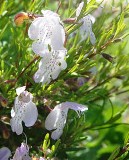 Short-leaved
rosemary (Conradina brevifolia)- Short-leaved rosemary is one
of five shrubby mints found in central Florida scrub habitat. This
species is a short-lived, aromatic, perennial shrub that grows to 1 m in
height. It has highly branched stems and leaves that are linear, 4-8 mm
long, and fleshy. The larger leaves on well-developed flowering branches
are 6 to 8.2 mm long and mostly shorter than the internodes. One to six
beautiful lavender flowers arise from the leaf axils. Short-leaved
rosemary occurs on the Lake Wales Ridge in dry, white sand soils with
scattered overstory of sand pine and scrub oak in clearings with other
endemic shrubs and herb scrub vegetation. The shrub is protected on Lake
Arbuckle State Forest and on land currently owned by The Nature
Conservancy at Saddle Blanket Lakes. Endemic to central Florida in
Highlands and Polk Counties, it is found at Sunray Hickory Lake, Avon
Park Lake, Silver Lake, Saddle Blanket Lakes and Carter Creek. Short-leaved
rosemary (Conradina brevifolia)- Short-leaved rosemary is one
of five shrubby mints found in central Florida scrub habitat. This
species is a short-lived, aromatic, perennial shrub that grows to 1 m in
height. It has highly branched stems and leaves that are linear, 4-8 mm
long, and fleshy. The larger leaves on well-developed flowering branches
are 6 to 8.2 mm long and mostly shorter than the internodes. One to six
beautiful lavender flowers arise from the leaf axils. Short-leaved
rosemary occurs on the Lake Wales Ridge in dry, white sand soils with
scattered overstory of sand pine and scrub oak in clearings with other
endemic shrubs and herb scrub vegetation. The shrub is protected on Lake
Arbuckle State Forest and on land currently owned by The Nature
Conservancy at Saddle Blanket Lakes. Endemic to central Florida in
Highlands and Polk Counties, it is found at Sunray Hickory Lake, Avon
Park Lake, Silver Lake, Saddle Blanket Lakes and Carter Creek.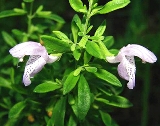 Etonia
rosemary (Conradina etonia)- Etonia rosemary is a federally
endangered plant from the mint family which is wholly found in one
population near Florahome, in Putnam County Florida. Found in deep
white sand scrub, Etonia Rosemary is a shrub that grows up to five feet
tall. Clusters of three to seven pale lavender flowers are produced
from about mid-stem and up. Many compounds in Etonia rosemary might have
insect repellent properties. Etonia
rosemary (Conradina etonia)- Etonia rosemary is a federally
endangered plant from the mint family which is wholly found in one
population near Florahome, in Putnam County Florida. Found in deep
white sand scrub, Etonia Rosemary is a shrub that grows up to five feet
tall. Clusters of three to seven pale lavender flowers are produced
from about mid-stem and up. Many compounds in Etonia rosemary might have
insect repellent properties.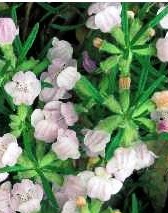 Apalachicola
rosemary (Conradina glabra)-This rare mint, the Apalachicola
rosemary, was listed as federally endangered in 1993. At that time,
there were seven known locations of this species, six of which were on
private timber company land. Since that time, the one population on
State land has disappeared, but The Nature Conservancy discovered two
new locations in or adjacent to one its preserves, and an exciting
reintroduction effort was carried out. This Florida-endemic mint is a
perennial shrub that grows to a height of 0.8 meters. The Apalachicola
rosemary has linear, aromatic evergreen leaves. The upper surface of
these leaves is smooth and hairless, while the lower surface is covered
with dense hairs that are visible only with magnification. The flowers
are white to pale lavender-pink flowers with a band of purple dots on
the white throat. Flowers arise from the leaf axils in groups of 2 or 3. Apalachicola
rosemary (Conradina glabra)-This rare mint, the Apalachicola
rosemary, was listed as federally endangered in 1993. At that time,
there were seven known locations of this species, six of which were on
private timber company land. Since that time, the one population on
State land has disappeared, but The Nature Conservancy discovered two
new locations in or adjacent to one its preserves, and an exciting
reintroduction effort was carried out. This Florida-endemic mint is a
perennial shrub that grows to a height of 0.8 meters. The Apalachicola
rosemary has linear, aromatic evergreen leaves. The upper surface of
these leaves is smooth and hairless, while the lower surface is covered
with dense hairs that are visible only with magnification. The flowers
are white to pale lavender-pink flowers with a band of purple dots on
the white throat. Flowers arise from the leaf axils in groups of 2 or 3.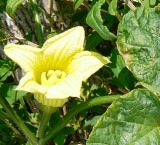 Okeechobee
gourd (Cucurbita okeechobeensis ssp. okeechobeensis)-The
Okeechobee gourd is a robust, often overwintering, herbaceous vine
endemic to Florida. Though originally observed by William Bartram in
1774 along the St. Johns River, in the eastern peninsula, it has since
been known only from the marshy shores of Lake Okeechobee, south-central
peninsular Florida. It has now been rediscovered in small numbers, still
extant along the St. Johns, where last seen by Bartram two and-a-quarter
centuries previously. A flowering vine, the Okeechobee gourd flowers
have 5 Regular Parts and are up to 2.75 inches. They are yellow or
cream. Blooms first appear in mid spring and continue into mid fall.
There are separate pistillate (female) and staminate (male) flowers. Okeechobee
gourd (Cucurbita okeechobeensis ssp. okeechobeensis)-The
Okeechobee gourd is a robust, often overwintering, herbaceous vine
endemic to Florida. Though originally observed by William Bartram in
1774 along the St. Johns River, in the eastern peninsula, it has since
been known only from the marshy shores of Lake Okeechobee, south-central
peninsular Florida. It has now been rediscovered in small numbers, still
extant along the St. Johns, where last seen by Bartram two and-a-quarter
centuries previously. A flowering vine, the Okeechobee gourd flowers
have 5 Regular Parts and are up to 2.75 inches. They are yellow or
cream. Blooms first appear in mid spring and continue into mid fall.
There are separate pistillate (female) and staminate (male) flowers.
|
|
|
Advertise | Privacy Statement | Dog Encyclopedia | Video |Contact | Alaska Nature |
|